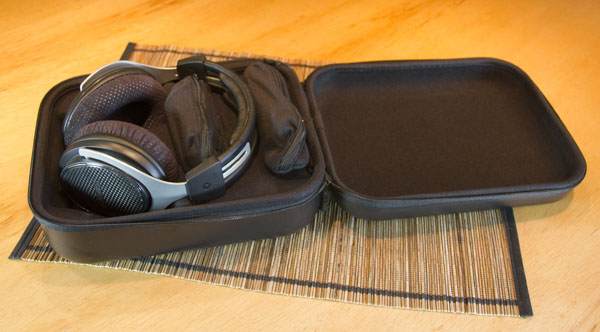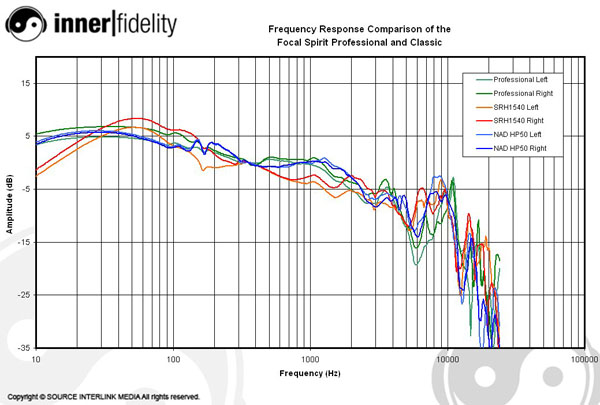| Columns Retired Columns & Blogs |
The Cool, Comfy, and Competent Shure SRH1540 Page 2

Sound Quality
Maybe I've just drunk too much of the Kool-Aid, but I have a hard time considering headphone frequency response without having the Harman target response curve in mind. My current tendency is to think it's a bit bass heavy and a bit rolled-off in the top two treble octaves. None the less, I think it's generally a better window into narrowing things down than the traditional compensation curves. To date, the two headphones I've found that most closely match the Harman curve—to the best of my ability to understand what that means—is the NAD VISO HP50 and Focal Spirit Professional. Both these cans follow the curve pretty closely in the bass, and might sound a tad too bass heavy. Both roll-off in the treble a bit less than the Harman curve, and are probably the better for it. But both do a great job through the mids, in my opinion.
In listening test I spent quite a bit of time comparing the Shure SRH1540 to the above two cans. In this case, the measurements do seem to tell the story well. Here's an ID (independent of direction) compensated frequency response plot comparing the three headphones.

Up to about 3kHz I'd say the Focal and NAD are pretty close to perfect tonally. You'll notice the Shure has a slightly elevated (about +3dB) mid-bass hump relative to the other two, and falls below the other two (about -5dB) from about the center of the mid-range (300Hz) to somewhere in the low-treble (2kHz). Then, regardless of where flat actually is in the treble, for most of the area between 5kHz and 20kHz the Shure is elevated by about 3-5dB relative to the other two.
Okay, that's a really long way to introduce the idea that the Shure SRH1540 is quite close to flat, but is just a bit "U" shaped. You know "fun" sounding. And that's exactly what you hear. To my ears the SRH1540 is just a tad too bass heavy and a tad too bright up top, but for the most part I'd call them a neutral headphone with a bit of character.
Now I have to say that at first I didn't like this. When I'm testing headphones, I listen at what I would consider a solid listening level—I suppose it's at about 80dBspl or so; a level that I would think recording engineers monitor at. For me, the SRH1540 at that level is too bright, and the bass a little too thick and slightly loose. A couple days later though, I was just sort of casually listening doing something else entirely when I found myself being really drawn into the music—it was super enjoyable. Once I consciously woke up to the fact that I was having a great time listening to these headphones and asked myself why, I figured out it was because I was listening at my normal, much lower level. That slightly "smiley-face" EQ acts quite nicely as a "loudness" contour and makes these headphones really sound great at modest levels.
But there's something else going on as well: The Shure SRH1540 is remarkably airy and open sounding. To my ears the treble, though a bit too emphasized at strong levels, is also very clean and artifact-free. Cymbals, brushes, and strings sound quite natural. Add to that the psychological factors of a physically very spacious and comfortable headphone around your ears, and a little lack of isolation in the high-frequencies to give you a sense of the actual space around you, and you have a nice mix of conditions that give you the impression of a very open headphone. At low listening levels when most closed headphones deliver a small image and a less consequential experience, the Shure SRH1540 continues to deliver an open sound with significant body and balance. I really, really, really like the sound of these cans at the modest levels I normally listen at.
I tend to think this is a mark against them for pro audio use, however. In that environment listening is most often done at fairly solid levels, and the slightly elevated treble might become a bit tiresome over time. On the other hand, I'm splitting hairs here, and I think many who like a slightly brighter presentation than I will love the SRH1540. It's certainly better balanced than the AKG K701 or Beyer DT880, which would sound thin in comparison.
Summary
Man, this is one hell of a headphone. Though it seems to me slightly hampered as a pro headphone by having a slightly "U" shaped EQ, and slightly hampered for the consumer due to lacking a smartphone cable, I can't but help fall in love with some of the things it does extraordinarily well.
For me, not having the folding mechanism is a huge plus. It rids the can of potential durability issues, and allows the SRH1540 to be both durable and light. The simple mechanism leads to a simple and elegant design. Money that might have been spent on the on the mechanics now go toward handsome and wonderfully comfortable materials. This is a full-size headphone not afraid to be a full-size headphone, and does it brilliantly.
I felt the sound quality of the SRH1540 was especially superb at low listening levels. The slightly "U" shaped frequency response acted very nicely as a "loudness" contour and let the music remain very enjoyable at very safe volumes. The mixture of supreme comfort and clear, articulate, well extended treble, gave a spacious image and a strong feeling of openness for a sealed headphone. Add that to the simply spectacular comfort of these headphones and the SRH1540 is headphone you can and likely will wear all day.
At loud listening levels, they were a bit too elevated in the treble, and a bit loose and elevated in the bass for me. But I know other's who enjoy a bit of that "U" fun EQ will say I'm nuts and these are spot on for them.
 I struggled with whether or not to put these on the "Wall of Fame." In the end their supreme comfort and stunningly spacious and clean response had me feeling they were the better choice relative to the slightly cramped fit and slightly inarticulate treble of the Focal Spirit Professional. I hasten to add however that the slightly smoother, punchier, and on target EQ response of the Focal might actually make it the better headphone for some pros. Both the above headphones and the NAD VISO HP50 are worthy of your personal audition in this category of headphone.
I struggled with whether or not to put these on the "Wall of Fame." In the end their supreme comfort and stunningly spacious and clean response had me feeling they were the better choice relative to the slightly cramped fit and slightly inarticulate treble of the Focal Spirit Professional. I hasten to add however that the slightly smoother, punchier, and on target EQ response of the Focal might actually make it the better headphone for some pros. Both the above headphones and the NAD VISO HP50 are worthy of your personal audition in this category of headphone.
Editor's Note: After further consideration I've decided to keep the Focal headphones on the Wall of Fame. The inability of the Shure to play well at loud levels makes the Focal can a continuing legitimate choice for audio pros and enthusiasts alike...even though their fit is a bit cramped. The Shure will still go up as a superior choice for it's comfort and extraordinary sound quality at low volumes.
Video
Resources
Shure home page and SRH1540 product page.
Head-Fi threads here, here, and here.
- Log in or register to post comments




































